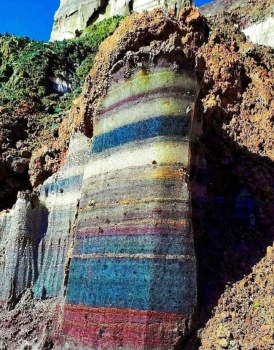Near the shores of Hormuz Island, where the Persian Gulf whispers against Iran’s southern edge, the earth has cracked open to reveal its secrets. Here, in Rainbow Valley, stone wears the hues of dreams—crimson, turquoise, gold—streaked across the land like a master artist’s careless, glorious brushstrokes. This is no human handiwork, but the patient labor of millennia: volcanic fury, the slow settle of minerals, the press of ancient seas.

Each ribbon of color tells a story. The reds are iron’s rusted breath, the blues and greens the whisper of copper, the yellows sulfur’s sharp signature. The white bands are salt, the dried tears of some primordial ocean. Wind and water have carved these layers into a towering spine, as if the earth itself arched its back to display its raw, radiant heart.
To stand before it is to stand before time itself. The rock does not merely endure; it burns with the memory of its making. Is this geology or art? A record of the past or a mirror for the imagination? Perhaps both. The land here bleeds color, a reminder that beauty is not always gentle—sometimes, it is forged in fire, pressed under weight, then unveiled by erosion’s relentless hand.
The pillar stands, silent and splendid. It asks no questions, offers no answers. Only this: look deeper. Beneath the surface of things, beneath even the skin of the world, there are colors we have not yet named, and stories older than stone.
